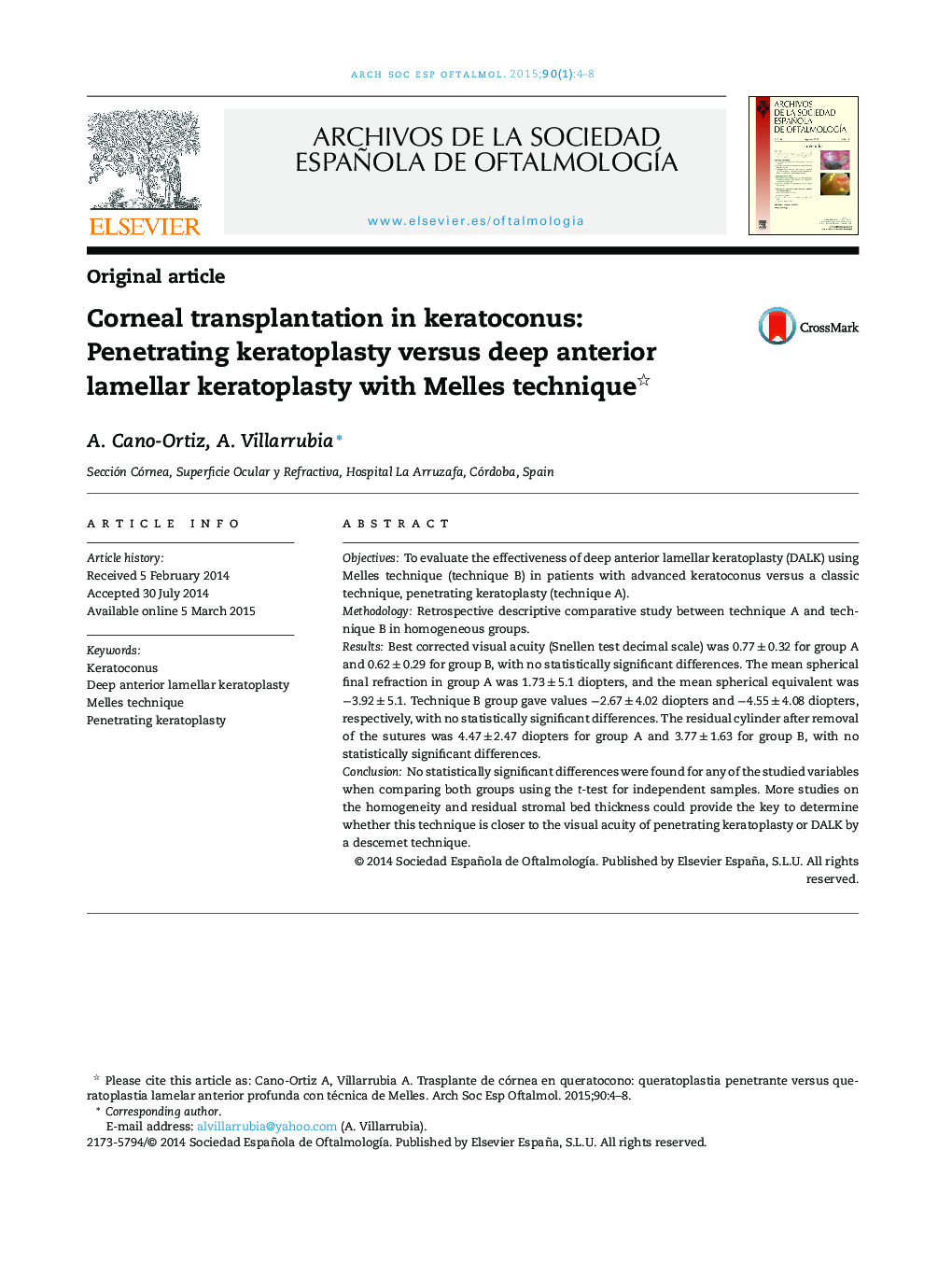| کد مقاله | کد نشریه | سال انتشار | مقاله انگلیسی | نسخه تمام متن |
|---|---|---|---|---|
| 4008226 | 1260857 | 2015 | 5 صفحه PDF | دانلود رایگان |
ObjectivesTo evaluate the effectiveness of deep anterior lamellar keratoplasty (DALK) using Melles technique (technique B) in patients with advanced keratoconus versus a classic technique, penetrating keratoplasty (technique A).MethodologyRetrospective descriptive comparative study between technique A and technique B in homogeneous groups.ResultsBest corrected visual acuity (Snellen test decimal scale) was 0.77 ± 0.32 for group A and 0.62 ± 0.29 for group B, with no statistically significant differences. The mean spherical final refraction in group A was 1.73 ± 5.1 diopters, and the mean spherical equivalent was −3.92 ± 5.1. Technique B group gave values −2.67 ± 4.02 diopters and −4.55 ± 4.08 diopters, respectively, with no statistically significant differences. The residual cylinder after removal of the sutures was 4.47 ± 2.47 diopters for group A and 3.77 ± 1.63 for group B, with no statistically significant differences.ConclusionNo statistically significant differences were found for any of the studied variables when comparing both groups using the t-test for independent samples. More studies on the homogeneity and residual stromal bed thickness could provide the key to determine whether this technique is closer to the visual acuity of penetrating keratoplasty or DALK by a descemet technique.
ResumenObjetivosEvaluar la eficacia de la queratoplastia lamelar anterior profunda (DALK) mediante técnica de Melles (técnica B) en pacientes con queratocono avanzado en comparación con la técnica clásica de queratoplastia penetrante (QPP) (técnica A).MetodologíaEstudio retrospectivo descriptivo comparativo entre la técnica A y la técnica B en grupos homogéneos.ResultadosLa agudeza visual con corrección (test de Snellen, escala decimal) ha sido de 0,77 ± 0,32 para el grupo A y de 0,62 ± 0,29 para el grupo B, no siendo diferencias estadísticamente significativas. El defecto refractivo esférico medio en el grupo A fue de −1,73 ± 5,1 dioptrías y el equivalente esférico medio de −3,92 ± 5,1 dioptrías. El grupo B presentó valores de −2,67 ± 4,02 dioptrías y −4,55 ± 4,08 dioptrías, respectivamente, no habiendo diferencias para estas variables en ambos grupos. El cilindro residual una vez retiradas las suturas fue de 4,47 ± 2,47 dioptrías para el grupo A y de 3,77 ± 1,63 dioptrías para el grupo B, sin ser estadísticamente significativas.ConclusiónNo se han encontrado diferencias estadísticamente significativas para ninguna de las variables estudiadas al comparar ambos grupos mediante la t de Student para muestras independientes. Más estudios acerca de la homogeneidad del lecho estromal residual y del espesor del mismo pueden aportar las claves para que esta técnica se acerque a las agudezas visuales de una QPP o una DALK mediante técnica descemética.
Journal: Archivos de la Sociedad Española de Oftalmología (English Edition) - Volume 90, Issue 1, January 2015, Pages 4–8
